An Intelligent Hybrid Energy Management System for a Smart House Considering Bidirectional Power Flow and Various EV Charging Techniques
Abstract
:1. Introduction
1.1. Background and Motivation
1.2. Literature Review
1.3. Contribution and Paper Organization
- A detailed model of an SH is developed whose components include an EV, a micro-CHP system, a BESS, and an RES. The RES includes solar and wind energy conversion systems. The SH is connected to a bidirectional utility for which two typical types of tariffs (i.e., flat and variable tariff) are considered.
- Since the EV has special characteristics (i.e., it is a heavy electric load which raises electric demand significantly without affecting the thermal loads), there are several charging techniques to harmonize its impacts on the system. A comprehensive comparison of four charging methods is presented in this work.
- An optimization model for the IHEMS is defined, and the constraints are modeled for the components of a SH. The problem is designed to apply the real coded genetic algorithm (RCGA) which optimizes the scheduling and use of energy resources and responsive loads.
- To model and explain the role of various components of the SH, a comprehensive set of six case studies is developed. The simulation results demonstrated the interesting features of the optimization process and the developed model. The necessary conditions for optimal operation of the energy resources are also explored.
2. Development of SH Model
2.1. Modeling the FC
2.2. Modeling the EV
| , | Charging power (kW), and resultant SOC of EV (%) at interval i |
| , , | Plugged-in, Plugged-out, and Minimum SOC of EV(%) |
| d,ηEV | Daily traveled distance (km) and, Net drive efficiency (km/kWh) of EV |
| CEV | EV battery capacity (kWh) |
2.3. Modeling the BESS
2.4. Electricity Import and Export Tariffs
3. Optimization Model
- The forecasted data for wind and PV, and the thermal and electrical loads is available.
- The EV daily trip distance as well as the initial energy levels of the BESS, are known.
- The system installation costs are neglected.
3.1. Objective Function
| n,T | Total time, Span of the time interval (h) |
| α,β | FC Startup, Shutdown costs |
| CFC.i, CBL.i, CU.i, CB.i | Total cost of the FC, Boiler, Utility, BESS at interval i |
| Cgas | Cost for purchasing natural gas (/kW) |
| CUb, CUb | Base cost for Buying, Selling utility electricity (/kW) |
| CBom | Operation and maintenance cost of BESS (/kW) |
| PFC.i | FC electrical power output at interval i (kW) |
| HBL.i | Thermal power produced by the boiler at interval i (kW) |
| PU.i | Electrical power purchased from, or sold to, the utility at interval i (kW). |
| Tb,Ts | Multipliers for Buying, Selling tariff as described in Table 1 |
| ηFC.i | FC efficiency |
3.2. Constraints
3.2.1. Power Balance Constraints
Electrical Power Balance
| PD.i | Electrical demand at interval i (kW) |
| PW.i, PPV.i | Wind, PV powers at i-th interval (kW) |
| PB.i | BESS charging or discharging power at i-th interval (kW). |
| PEV.i | EV charging power at i-th interval (kW) |
| ηch,ηdch | Charging, Discharging efficiencies of the BESS |
Thermal Power Balance
3.2.2. Constraints of Devices
Constraints of FC
| ΔPFCup, ΔPFCdn | FC ramp up, ramp down rates |
| PFCmin, PFCmax | FC minimum, maximum power limit |
Constraints of EV
Constraints of BESS
| WB.i | Energy level in the BESS at i-th interval (kWh) |
| WBmin, WBmax | Minimum, Maximum energy limits in BESS (kWh) |
| PBchmax, PBdchmax | Maximum rates of Charging, Discharging of BESS (kW) |
3.3. Renewable Energy Generation
4. Real Coded Genetic Algorithm
4.1. Step I: Initialization
4.2. Step 2: Implementation of the Constraints
4.3. Step 3: Using RCGA Operators
4.3.1. Selection
4.3.2. Crossover
4.3.3. Mutation
5. Simulation Results
5.1. Base Case
5.2. Case 1: Addition of RES
- In supplying the electrical loads, the wind and solar power resources must be given priority.
- Heating is still provided by the auxiliary boiler.
- Bidirectional power flow is considered. In this way, the consumers can sell surplus electric energy to the utility.
- The RES curve in the subsequent figures is the summation of both wind and PV output powers in each time interval.
5.3. Case 2: FC Included
5.4. Case 3: BESS Included
5.5. Case 4: Variable Tariff Considered
5.6. Case 5: EV Included
5.7. Case 6: Scheduling of the EV Charging
5.7.1. EVSE-2
5.7.2. EVSE-3
5.7.3. EVSE-4
6. Conclusions
Author Contributions
Funding
Conflicts of Interest
References
- Rolfsman, B. CO2 emission consequences of energy measures in buildings. Build. Environ. 2002, 1421–1430. [Google Scholar] [CrossRef]
- Murugan, S.; Horák, B. A review of micro combined heat and power systems for residential applications. Renew. Sustain. Energy Rev. 2016, 64, 144–162. [Google Scholar] [CrossRef]
- Benam, M.R.; Madani, S.S.; Alavi, S.M.; Ehsan, M. Optimal Configuration of the CHP System Using Stochastic Programming. IEEE Trans. Power Deliv. 2015, 30, 1048–1056. [Google Scholar] [CrossRef]
- El-Sharkh, M.Y.; Rahman, A.; Alam, M.S.; El-Keib, A.A. Thermal energy management of a CHP hybrid of wind and a grid-parallel PEM fuel cell power plant. In Proceedings of the 2009 IEEE/PES Power Systems Conference and Exposition, Seattle, WA, USA, 15–18 March 2009; pp. 1–6. [Google Scholar]
- Nehrir, M.H.; Wang, C. Hybrid Fuel Cell Based Energy System Case Studies. In Modeling and Control of Fuel Cells: Distributed Generation Applications; Wiley-IEEE Press: Hoboken, NJ, USA, 2009; pp. 219–264. [Google Scholar] [CrossRef]
- Adam, A.; Fraga, E.S.; Brett, D.J.L. Options for residential building services design using fuel cell based micro-CHP and the potential for heat integration. Appl. Energy 2015, 138, 685–694. [Google Scholar] [CrossRef]
- Feng, Z.B.; Jin, H.G. Part-load performance of CCHP with gas turbine and storage system. Proc. CSEE 2006, 26, 25–30. [Google Scholar]
- Combined Heat and Power (CHP). Available online: http://aceee.org/topics/combined-heat-and-power-chp (accessed on 25 February 2019).
- Khan, S.U.; Mehmood, K.K.; Haider, Z.M.; Rafique, M.K.; Kim, C.H. A Bi-Level EV Aggregator Coordination Scheme for Load Variance Minimization with Renewable Energy Penetration Adaptability. Energies 2018, 11, 2809. [Google Scholar] [CrossRef]
- Khan, S.U.; Mehmood, K.K.; Haider, Z.M.; Bukhari, S.B.A.; Lee, S.J.; Rafique, M.K.; Kim, C.H. Energy Management Scheme for an EV Smart Charger V2G/G2V Application with an EV Power Allocation Technique and Voltage Regulation. Appl. Sci. 2018, 8, 648. [Google Scholar] [CrossRef]
- García-Villalobos, J.; Zamora, I.; San Martín, J.I.; Asensio, F.J.; Aperribay, V. Plug-in electric vehicles in electric distribution networks: A review of smart charging approaches. Renew. Sustain. Energy Rev. 2014, 38, 717–731. [Google Scholar] [CrossRef]
- Sanguinetti, A.; Karlin, B.; Ford, R.; Salmon, K.; Dombrovski, K. What’s energy management got to do with it? Exploring the role of energy management in the smart home adoption process. Energy Effic. 2018, 11, 1897–1911. [Google Scholar] [CrossRef]
- Ford, R.; Pritoni, M.; Sanguinetti, A.; Karlin, B. Categories and functionality of smart home technology for energy management. Build. Environ. 2017, 123, 543–554. [Google Scholar] [CrossRef]
- Xie, D.; Lu, Y.; Sun, J.; Gu, C.; Li, G. Optimal Operation of a Combined Heat and Power System Considering Real-time Energy Prices. IEEE Access 2016, 4, 3005–3015. [Google Scholar] [CrossRef]
- Ashique, R.H.; Salam, Z.; Aziz, M.J.B.A.; Bhatti, A.R. Integrated photovoltaic-grid dc fast charging system for electric vehicle: A review of the architecture and control. Renew. Sustain. Energy Rev. 2017, 69, 1243–1257. [Google Scholar] [CrossRef]
- Dubey, A.; Santoso, S. Electric Vehicle Charging on Residential Distribution Systems: Impacts and Mitigations. IEEE Access 2015, 3, 1871–1893. [Google Scholar] [CrossRef]
- Cao, Y.; Tang, S.; Li, C.; Zhang, P.; Tan, Y.; Zhang, Z.; Li, J. An Optimized EV Charging Model Considering TOU Price and SOC Curve. IEEE Trans. Smart Grid 2012, 3, 388–393. [Google Scholar] [CrossRef] [Green Version]
- Romano, R.; Siano, P.; Acone, M.; Loia, V. Combined Operation of Electrical Loads, Air Conditioning and Photovoltaic-Battery Systems in Smart Houses. Appl. Sci. 2017, 7, 525. [Google Scholar] [CrossRef]
- Mohsenian-Rad, H.; Ghamkhari, M. Optimal Charging of Electric Vehicles With Uncertain Departure Times: A Closed-Form Solution. IEEE Trans. Smart Grid 2015, 6, 940–942. [Google Scholar] [CrossRef]
- Saeed Uz Zaman, M.; Bukhari, S.B.A.; Hazazi, K.M.; Haider, Z.M.; Haider, R.; Kim, C.H. Frequency Response Analysis of a Single-Area Power System with a Modified LFC Model Considering Demand Response and Virtual Inertia. Energies 2018, 11, 787. [Google Scholar] [CrossRef]
- Haider, Z.M.; Mehmood, K.K.; Rafique, M.K.; Khan, S.U.; Soon-Jeong, L.; Chul-Hwan, K. Water-filling algorithm based approach for management of responsive residential loads. J. Mod. Power Syst. Clean Energy 2018, 6, 118–131. [Google Scholar] [CrossRef]
- Yao, L.; Damiran, Z.; Lim, W.H. Optimal Charging and Discharging Scheduling for Electric Vehicles in a Parking Station with Photovoltaic System and Energy Storage System. Energies 2017, 10, 550. [Google Scholar] [CrossRef]
- Angrisani, G.; Canelli, M.; Roselli, C.; Sasso, M. Integration between electric vehicle charging and micro-cogeneration system. Energy Convers. Manag. 2015, 98, 115–126. [Google Scholar] [CrossRef]
- Yokoyama, T.W.N.W.R. Energy-saving effect of a residential polymer electrolyte fuel cell cogeneration system combined with a plug-in hybrid electric vehicle. Energy Convers. Manag. 2014, 77, 40–51. [Google Scholar] [CrossRef]
- Yokoyama, T.W.N.W.R. Feasibility study on combined use of residential SOFC cogeneration system and plug-in hybrid electric vehicle from energy-saving viewpoint. Energy Convers. Manag. 2012, 170–179. [Google Scholar] [CrossRef]
- Entchev, H.R.E. Exploring the potential synergy between micro-cogeneration and electric vehicle charging. Appl. Therm. Eng. 2014, 677–685. [Google Scholar] [CrossRef]
- Liu, H.; Wang, B.; Wang, N.; Wu, Q.; Yang, Y.; Wei, H.; Li, C. Enabling strategies of electric vehicles for under frequency load shedding. Appl. Energy 2018, 228, 843–851. [Google Scholar] [CrossRef]
- Jin, C.; Sheng, X.; Ghosh, P. Energy efficient algorithms for Electric Vehicle charging with intermittent renewable energy sources. In Proceedings of the 2013 IEEE Power Energy Society General Meeting, Vancouver, BC, Canada, 21–25 July 2013; pp. 1–5. [Google Scholar] [CrossRef]
- Domínguez-Navarro, J.; Dufo-López, R.; Yusta-Loyo, J.; Artal-Sevil, J.; Bernal-Agustín, J. Design of an electric vehicle fast-charging station with integration of renewable energy and storage systems. Int. J. Electr. Power Energy Syst. 2019, 105, 46–58. [Google Scholar] [CrossRef]
- Choi, S.H.; Hussain, A.; Kim, H.M. Adaptive Robust Optimization-Based Optimal Operation of Microgrids Considering Uncertainties in Arrival and Departure Times of Electric Vehicles. Energies 2018, 11, 2646. [Google Scholar] [CrossRef]
- Wu, X.; Hu, X.; Yin, X.; Moura, S.J. Stochastic Optimal Energy Management of Smart Home With PEV Energy Storage. IEEE Trans. Smart Grid 2018, 9, 2065–2075. [Google Scholar] [CrossRef]
- Liu, Z.; Wu, Q.; Shahidehpour, M.; Li, C.; Huang, S.; Wei, W. Transactive Real-time Electric Vehicle Charging Management for Commercial Buildings with PV On-site Generation. IEEE Trans. Smart Grid 2018. [Google Scholar] [CrossRef]
- Rafique, M.K.; Haider, Z.M.; Mehmood, K.K.; Saeed Uz Zaman, M.; Irfan, M.; Khan, S.U.; Kim, C.H. Optimal Scheduling of Hybrid Energy Resources for a Smart Home. Energies 2018, 11, 3201. [Google Scholar] [CrossRef]
- Gunes, M.B. Investigation of a Fuel Cell Based Total Energy System for Residential Applications. Ph.D. Thesis, Virginia Tech, Blacksburg, VA, USA, 2001. [Google Scholar]
- Methipara, J.; Reuscher, T.; Santos, A. Electric Vehicle Feasibility: Can EVs Take US Households to Where They Need to Go? Technical Report; National Household Travel Survey: Washington, DC, USA, 2016.
- Santos, A.; McGuckin, N.; Nakamoto, H.Y.; Gray, D.; Liss, S. Summary of Travel Trends; Technical Report; National Household Travel Survey, Department of Transportation: Washington, DC, USA, 2009.
- Hu, Z.; Han, X.; Wen, Q. Integrated Resource Strategic Planning and Power Demand-Side Management; Power Systems; Springer: Berlin, Germany, 2013. [Google Scholar]
- Gianfreda, A.; Grossi, L. Zonal price analysis of the Italian wholesale electricity market. In Proceedings of the 2009 6th International Conference on the European Energy Market, Leuven, Belgium, 27–29 May 2009; pp. 1–6. [Google Scholar] [CrossRef]
- Gu, W.; Wu, Z.; Yuan, X. Microgrid economic optimal operation of the combined heat and power system with renewable energy. In Proceedings of the 2010 IEEE Power and Energy Society General Meeting, Minneapolis, MN, USA, 25–29 July 2010; pp. 1–6. [Google Scholar] [CrossRef]
- Safari, N.; Chung, C.Y.; Price, G.C.D. Novel Multi-Step Short-Term Wind Power Prediction Framework Based on Chaotic Time Series Analysis and Singular Spectrum Analysis. IEEE Trans. Power Syst. 2018, 33, 590–601. [Google Scholar] [CrossRef]
- Barque, M.; Martin, S.; Vianin, J.E.N.; Genoud, D.; Wannier, D. Improving wind power prediction with retraining machine learning algorithms. In Proceedings of the 2018 International Workshop on Big Data and Information Security (IWBIS), Jakarta, Indonesia, 12–13 May 2018; pp. 43–48. [Google Scholar] [CrossRef]
- Dou, C. Hybrid model for renewable energy and loads prediction based on data mining and variational mode decomposition. IET Gener. Transm. Distrib. 2018, 12, 2642–2649. [Google Scholar] [CrossRef]
- Michalewicz, Z. Genetic Algorithms + Data Structures = Evolution Programs, 3rd ed.; Springer-Verlag: London, UK, 1996. [Google Scholar]
- Damousis, I.G.; Bakirtzis, A.G.; Dokopoulos, P.S. Network-constrained economic dispatch using real-coded genetic algorithm. IEEE Trans. Power Syst. 2003, 18, 198–205. [Google Scholar] [CrossRef] [Green Version]
- Kuri-Morales, A.F.; Gutiérrez-García, J. Penalty Function Methods for Constrained Optimization with Genetic Algorithms: A Statistical Analysis. In Proceedings of the MICAI 2002: Advances in Artificial Intelligence: Second Mexican International Conference on Artificial Intelligence Mérida, Yucatán, Mexico, 22–26 April 2002; Coello Coello, C.A., de Albornoz, A., Sucar, L.E., Battistutti, O.C., Eds.; Springer: Berlin/Heidelberg, Germany, 2002; pp. 108–117. [Google Scholar] [CrossRef]
- Amjady, N.; Nasiri-Rad, H. Economic dispatch using an efficient real-coded genetic algorithm. IET Gener. Transm. Distrib. 2009, 3, 266–278. [Google Scholar] [CrossRef]
- Goldberg, D. Genetic Algorithms in Search, Optimization, and Machine Learning; Artificial Intelligence; Addison-Wesley Publishing Company: Boston, MA, USA, 1989. [Google Scholar]
- Blasco Ferragud, F.X. Control Predictivo Basado en Modelos Mediante Tecnicas de Optimizacion Heuristica. Aplicacion a Procesos no Lineales y Multivariables. Ph.D. Thesis, Universitat Politècnica de València, València, Spain, 1999. [Google Scholar]
- Herrera, F.; Lozano, M.; Verdegay, J. Tackling Real-Coded Genetic Algorithms: Operators and Tools for Behavioural Analysis. Artif. Intell. Rev. 1998, 12, 265–319. [Google Scholar] [CrossRef]
- Mühlenbein, H.; Schlierkamp-Voosen, D. Predictive Models for the Breeder Genetic Algorithm–I. Continuous Parameter Optimization. Evolut. Comput. 1993, 1, 25–49. [Google Scholar] [CrossRef]
- De Jong, K.A. An Analysis of the Behavior of a Class of Genetic Adaptive Systems. Ph.D. Thesis, University of Michigan, Ann Arbor, MI, USA, 1975. [Google Scholar]
- Linkevics, O.; Sauhats, A. Formulation of the objective function for economic dispatch optimisation of steam cycle CHP plants. In Proceedings of the 2005 IEEE Russia Power Tech, St. Petersburg, Russia, 27–30 June 2005; pp. 1–6. [Google Scholar] [CrossRef]
- Mitsubihsi i-MiEV Specifications. Available online: https://www.mitsubishi-motors.com/en/showroom/i-miev/specifications/ (accessed on 25 February 2019).
- Charging Unit VersiCharge IEC. Available online: https://www.siemens.com/global/en/home/products/energy/low-voltage/components/electric-vehicle–ev–charging/versicharge-iec.html (accessed on 25 February 2019).
- Awadallah, M.A.; Singh, B.N.; Venkatesh, B. Impact of EV Charger Load on Distribution Network Capacity: A Case Study in Toronto. Can. J. Electr. Comput. Eng. 2016, 39, 268–273. [Google Scholar] [CrossRef]
- McCarthy, D.; Wolfs, P. The HV system impacts of large scale electric vehicle deployments in a metropolitan area. In Proceedings of the 2010 20th Australasian Universities Power Engineering Conference, Christchurch, New Zealand, 5–8 December 2010; pp. 1–6. [Google Scholar]

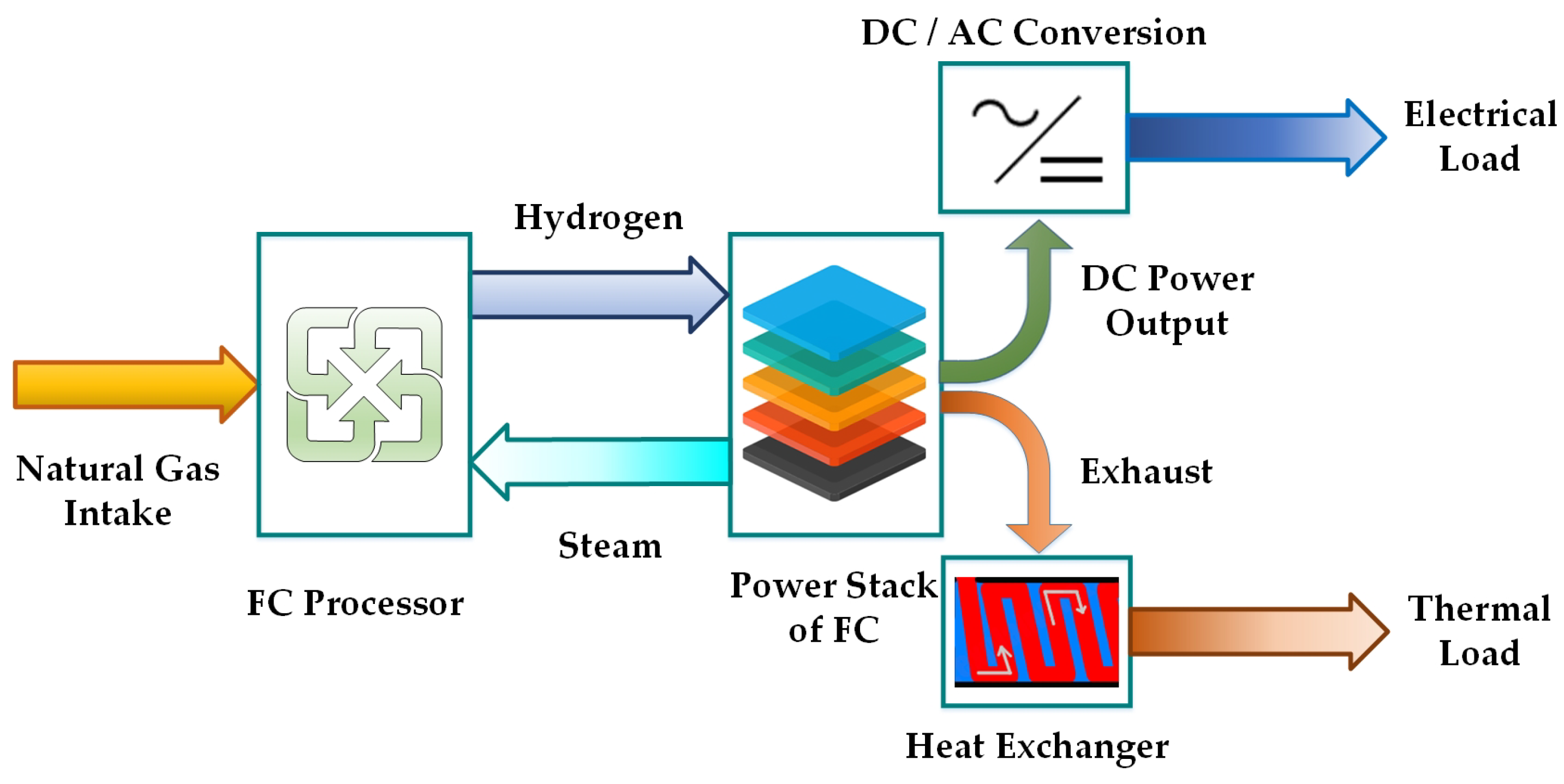
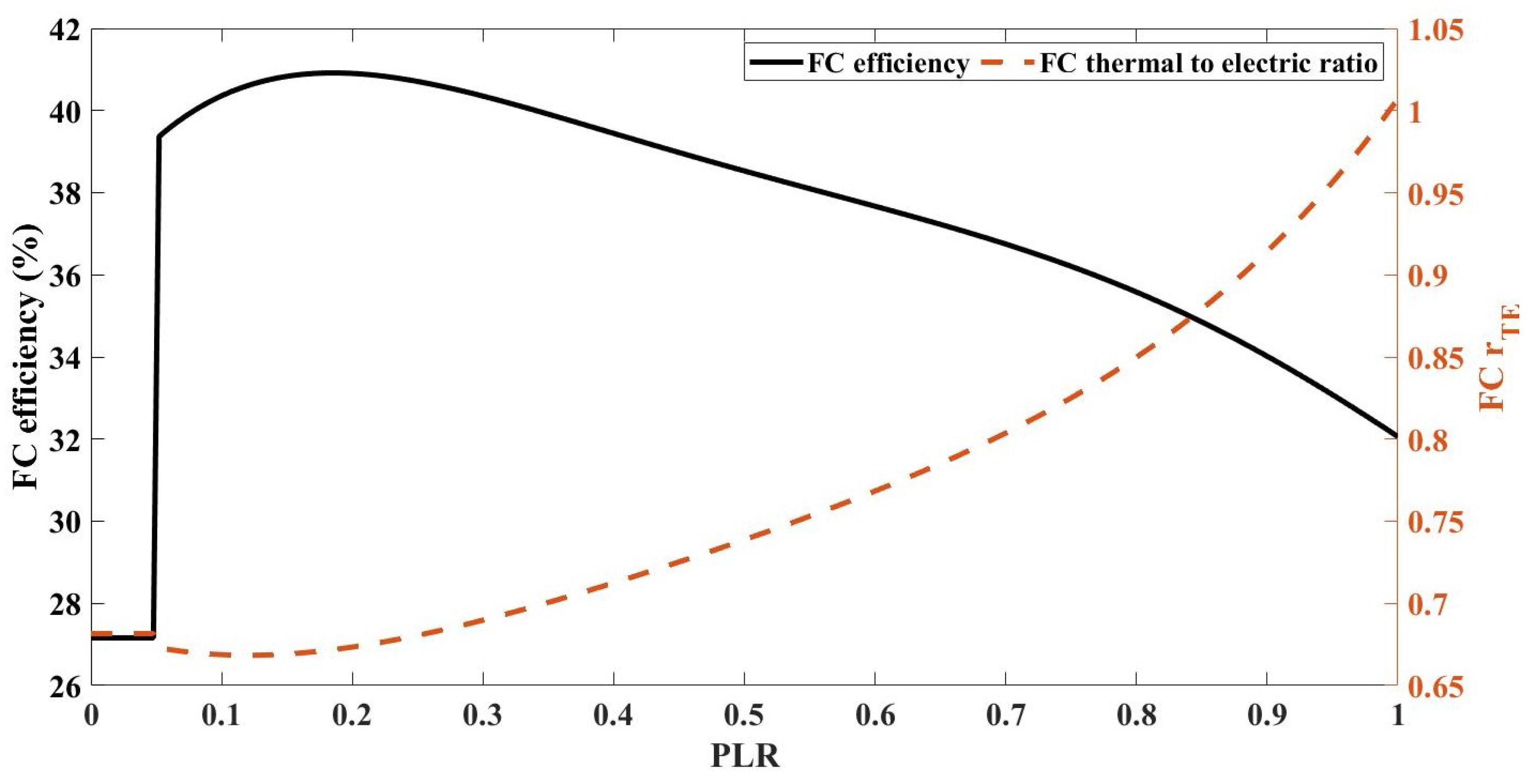
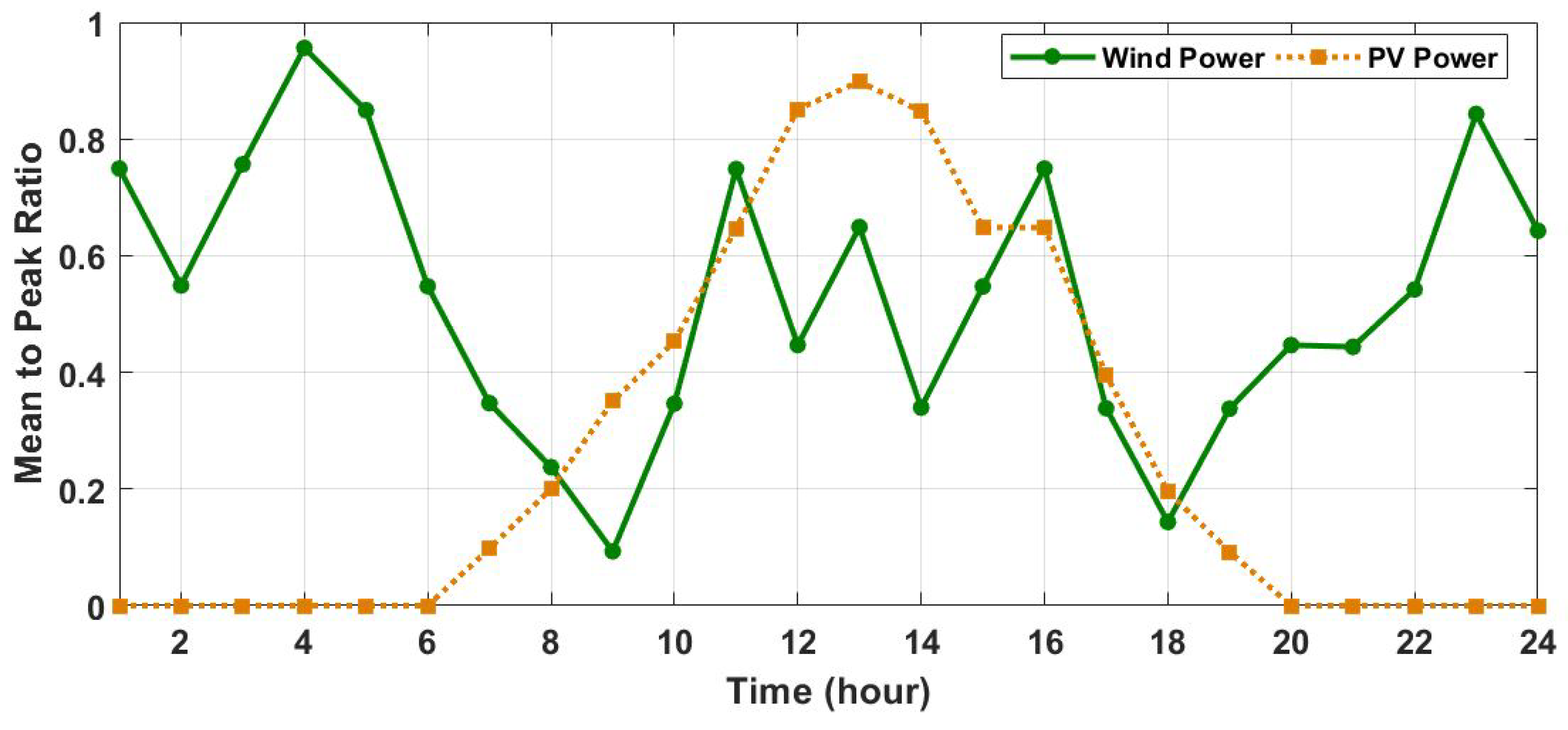

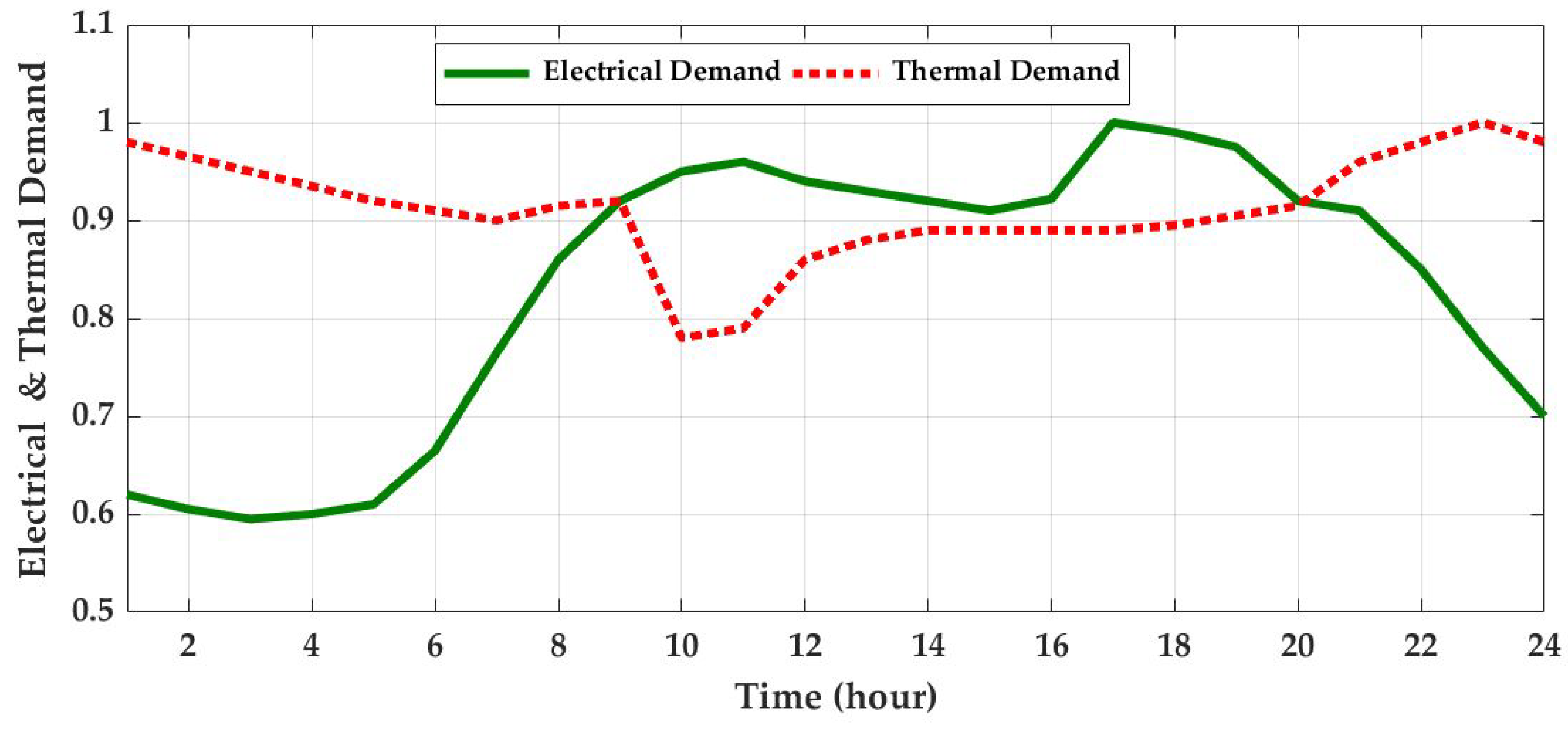

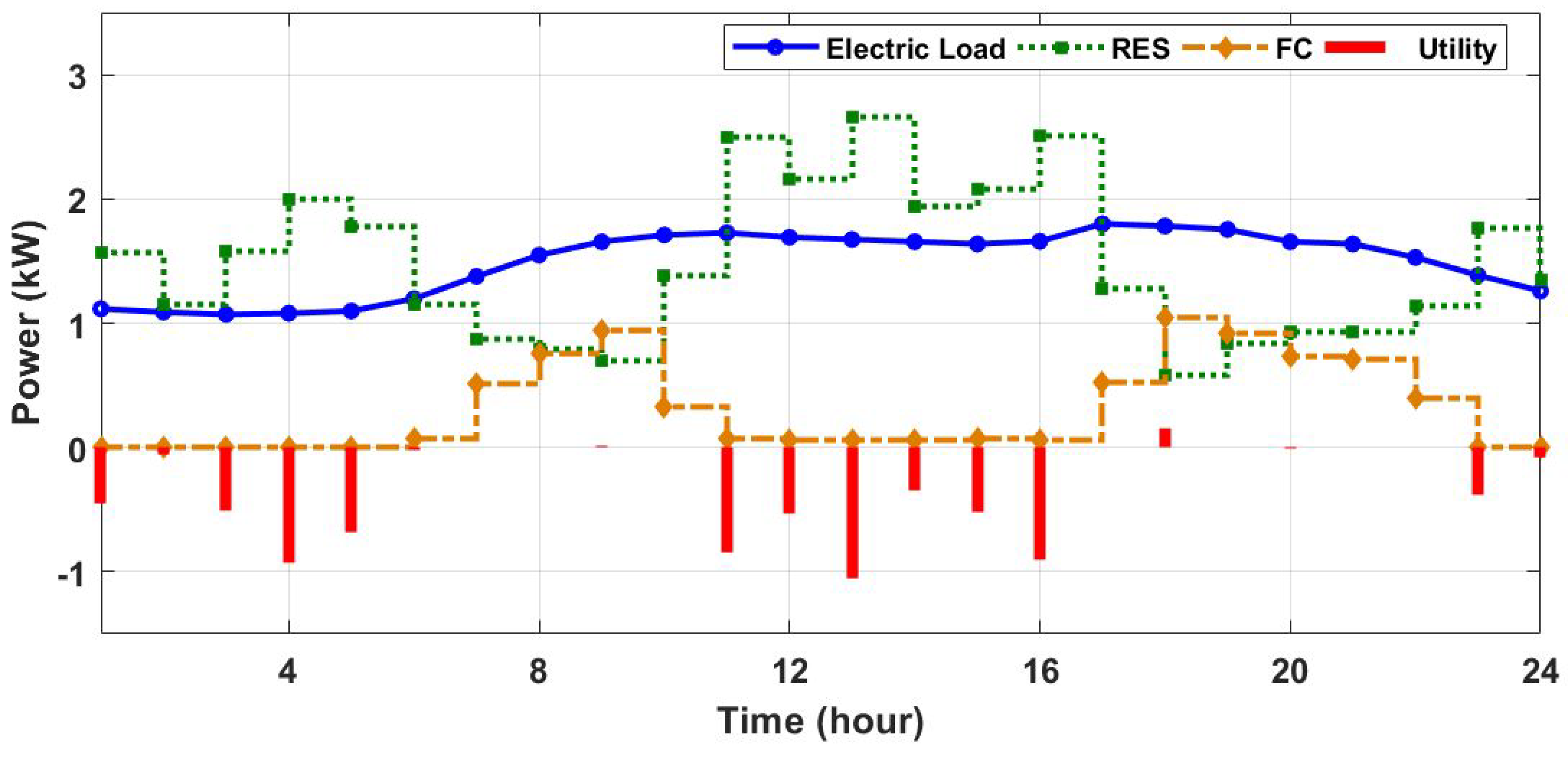
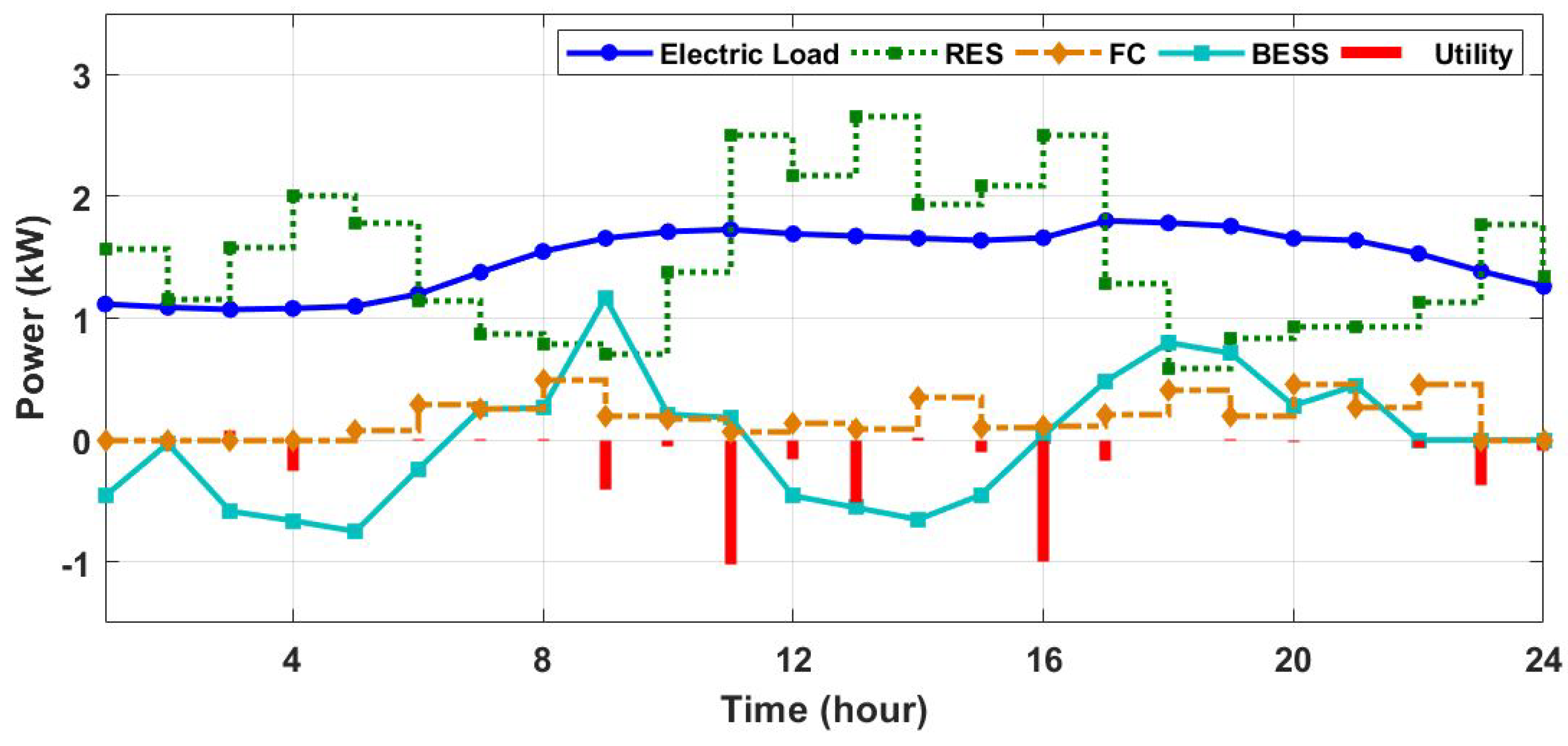

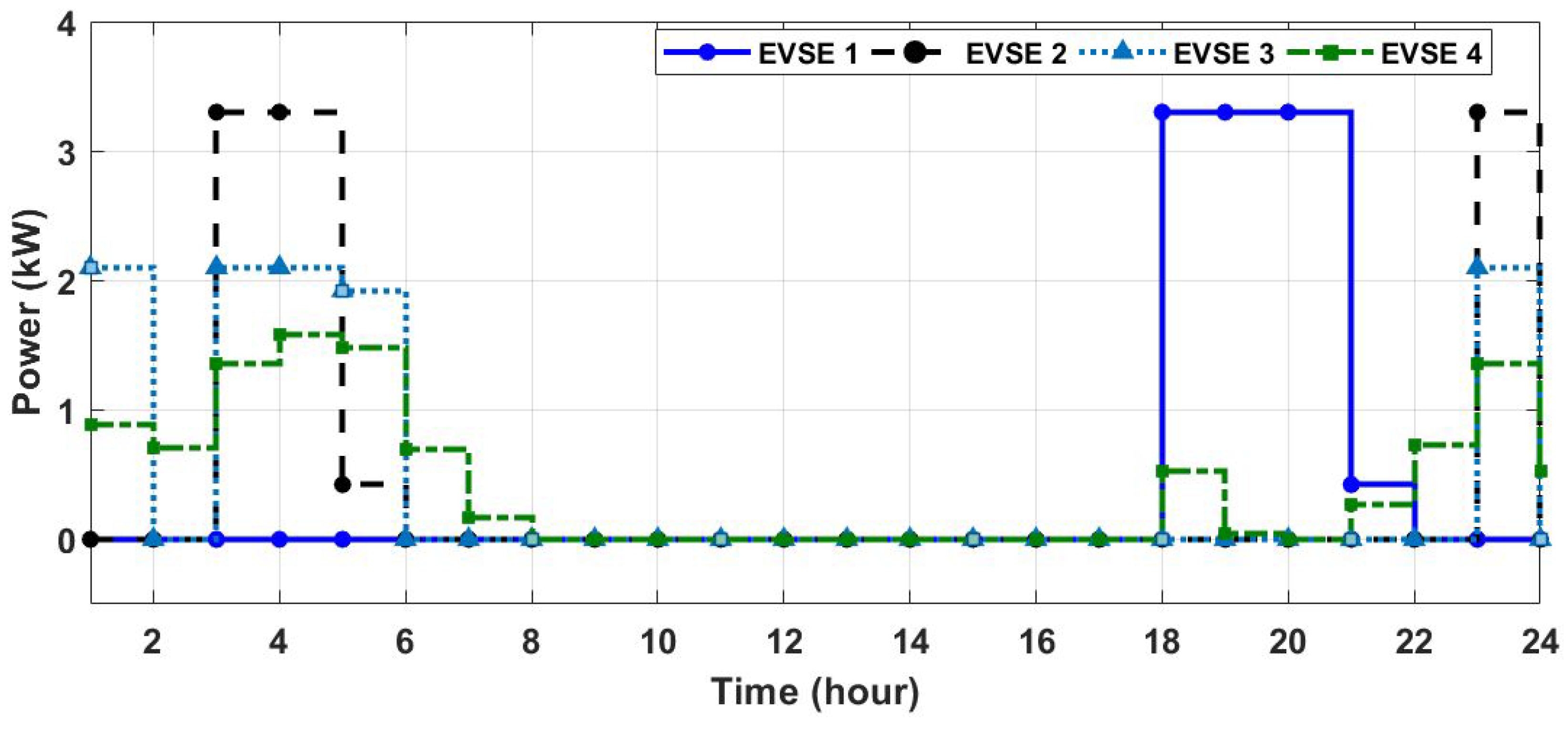




| Type | Time Span | Normalized Import Price | Normalized Export Price |
|---|---|---|---|
| Peak Tariff | [09:00–12:00] | 1 | 1 |
| [17:00–22:00] | |||
| Plain Tariff | [13:00–16:00] | 0.9 | 0.8 |
| Valley Tariff | [01:00–08:00] | 0.78 | 0.6 |
| [23:00–24:00] |
| Case No | RES | FC | BESS | Variable Tariff | Inclusion of EV | Scheduling of EV |
|---|---|---|---|---|---|---|
| Base | ✗ | ✗ | ✗ | ✗ | ✗ | ✗ |
| 1 | ✓ | ✗ | ✗ | ✗ | ✗ | ✗ |
| 2 | ✓ | ✓ | ✗ | ✗ | ✗ | ✗ |
| 3 | ✓ | ✓ | ✓ | ✗ | ✗ | ✗ |
| 4 | ✓ | ✓ | ✓ | ✓ | ✗ | ✗ |
| 5 | ✓ | ✓ | ✓ | ✓ | ✓ | ✗ |
| 6 | ✓ | ✓ | ✓ | ✓ | ✓ | ✓ |
| Value | Unit | Value | Unit | ||
|---|---|---|---|---|---|
| EV | |||||
| d | 40 | mi | 100 | % | |
| 6.2 | - | 100 | % | ||
| 16 | (kWh) | 17:00 | hour | ||
| 3.3 | (kW) | 07:00 | hour | ||
| 20 | % | ||||
| FC | |||||
| 1.2 | (kW) | 0.9 | (kW) | ||
| 0.05 | (kW) | 0.15 | $ | ||
| 0.75 | (kW) | 0 | $ | ||
| BESS | |||||
| 3 | (kWh) | 2.25 | (kW) | ||
| 0 | (kWh) | 1 | - | ||
| −0.75 | (kW) | 0.001 | /kW) | ||
| General | RCGA Parameters | ||||
| n | 24 | hour | 0.5 | - | |
| T | 1 | hour | 0.1 | - | |
| 0.05 | /kW) | Renewables | |||
| 0.13 | /kW) | 2 | (kW) | ||
| 0.07 | /kW) | 1.3 | (kW) | ||
| Name | Type | Charging Rate | Time Event | Scheduling | Remarks |
|---|---|---|---|---|---|
| EVSE-1 | Normal/ Constant | Fixed at maximum | Continuous | NO | A continuous charging starts at at maximum rate |
| EVSE-2 | Constant scheduling | Fixed at maximum | Discontinuous/ Continuous | YES | ON & OFF capability is added to EVSE-1 for discontinuous charging for various time intervals |
| EVSE-3 | Discrete scheduling | Discrete values | Discontinuous/ Continuous | YES | EV is charged using discrete powers in the set {3.3, 3, 2.7, 2.4, 2.1} with ON & OFF capability |
| EVSE-4 | Adaptive scheduling | Continuous | Discontinuous/ Continuous | YES | EV gets charged with powers in the continuous range from minimum to maximum rating of the charger with ON & OFF capability |
| Devices | Base Case | Case 1 | Case 2 | Case 3 | Case 4 | Case 5 | Case 6 |
|---|---|---|---|---|---|---|---|
| Boiler Cost ($/day) | 2.19 | 2.19 | 1.90 | 2.04 | 2.02 | 1.92 | 1.79 |
| FC Cost ($/day) | 0 | 0 | 0.98 | 0.54 | 0.60 | 0.93 | 1.41 |
| Utility Cost ($/day) | 4.65 | 0.44 | −0.49 | −0.24 | −0.32 | 0.72 | 0.04 |
| Net Cost ($/day) | 6.84 | 2.63 | 2.4 | 2.34 | 2.30 | 3.56 | 3.24 |
| Saving relative to the previous case (%) | 62 | 9 | 3 | 2 | −55 | 9 | |
| Saving relative to Base Case (%) | 61.55 | 64.91 | 65.79 | 66.37 | 47.95 | 52.63 |
| Power Demand and Generation | Costs | ||||||||||||
|---|---|---|---|---|---|---|---|---|---|---|---|---|---|
| Total | |||||||||||||
| h | (kW) | (kW) | (kW) | (kW) | (kW) | (kW) | (kW) | (kW) | (kW) | ($/day) | ($/day) | ($/day) | ($/day) |
| 1 | 1.12 | 0.89 | 1.57 | 0.56 | −0.13 | 0.00 | 1.96 | 0.41 | 1.55 | 0.08 | 0.07 | 0 | 0.15 |
| 2 | 1.09 | 0.70 | 1.15 | 0.52 | −0.03 | 0.16 | 1.93 | 0.37 | 1.56 | 0.08 | 0.07 | 0.02 | 0.16 |
| 3 | 1.07 | 1.36 | 1.58 | 0.68 | 0.16 | 0.01 | 1.90 | 0.51 | 1.39 | 0.07 | 0.09 | 0 | 0.16 |
| 4 | 1.08 | 1.58 | 2.00 | 0.66 | −0.03 | 0.04 | 1.87 | 0.50 | 1.37 | 0.07 | 0.09 | 0 | 0.16 |
| 5 | 1.10 | 1.48 | 1.78 | 0.46 | 0.03 | 0.31 | 1.84 | 0.32 | 1.52 | 0.08 | 0.06 | 0.03 | 0.16 |
| 6 | 1.20 | 0.69 | 1.15 | 0.60 | 0.00 | 0.14 | 1.82 | 0.44 | 1.38 | 0.07 | 0.08 | 0.01 | 0.16 |
| 7 | 1.38 | 0.17 | 0.87 | 0.56 | 0.00 | 0.12 | 1.80 | 0.40 | 1.40 | 0.07 | 0.07 | 0.01 | 0.15 |
| 8 | 1.55 | 0.00 | 0.79 | 0.48 | −0.01 | 0.30 | 1.83 | 0.34 | 1.49 | 0.07 | 0.06 | 0.03 | 0.17 |
| 9 | 1.66 | 0.00 | 0.70 | 0.93 | 0.00 | 0.02 | 1.84 | 0.78 | 1.06 | 0.05 | 0.13 | 0 | 0.19 |
| 10 | 1.71 | 0.00 | 1.38 | 0.37 | 0.01 | −0.05 | 1.56 | 0.25 | 1.31 | 0.07 | 0.05 | 0 | 0.11 |
| 11 | 1.73 | 0.00 | 2.50 | 0.16 | −0.74 | −0.20 | 1.58 | 0.11 | 1.47 | 0.07 | 0.02 | −0.01 | 0.08 |
| 12 | 1.69 | 0.00 | 2.17 | 0.08 | −0.01 | −0.54 | 1.72 | 0.05 | 1.67 | 0.08 | 0.01 | −0.04 | 0.06 |
| 13 | 1.67 | 0.00 | 2.66 | 0.08 | −0.67 | −0.40 | 1.76 | 0.05 | 1.71 | 0.09 | 0.01 | −0.02 | 0.07 |
| 14 | 1.66 | 0.00 | 1.94 | 0.18 | −0.46 | 0.00 | 1.78 | 0.12 | 1.66 | 0.08 | 0.02 | 0 | 0.11 |
| 15 | 1.64 | 0.00 | 2.08 | 0.16 | −0.67 | 0.07 | 1.78 | 0.10 | 1.68 | 0.08 | 0.02 | 0.01 | 0.11 |
| 16 | 1.66 | 0.00 | 2.51 | 0.09 | −0.33 | −0.60 | 1.78 | 0.06 | 1.72 | 0.09 | 0.01 | −0.03 | 0.06 |
| 17 | 1.80 | 0.00 | 1.28 | 0.18 | 0.36 | −0.02 | 1.78 | 0.12 | 1.66 | 0.08 | 0.02 | 0 | 0.1 |
| 18 | 1.78 | 0.53 | 0.58 | 0.56 | 1.17 | 0.00 | 1.79 | 0.41 | 1.38 | 0.07 | 0.07 | 0 | 0.14 |
| 19 | 1.76 | 0.04 | 0.84 | 0.50 | 0.42 | 0.04 | 1.81 | 0.36 | 1.45 | 0.07 | 0.06 | 0 | 0.14 |
| 20 | 1.66 | 0.00 | 0.93 | 0.59 | 0.13 | 0.00 | 1.83 | 0.44 | 1.39 | 0.07 | 0.08 | 0 | 0.15 |
| 21 | 1.64 | 0.27 | 0.93 | 0.70 | 0.28 | 0.00 | 1.92 | 0.53 | 1.39 | 0.07 | 0.09 | 0 | 0.16 |
| 22 | 1.53 | 0.72 | 1.13 | 0.74 | 0.38 | 0.00 | 1.96 | 0.58 | 1.38 | 0.07 | 0.1 | 0 | 0.17 |
| 23 | 1.39 | 1.36 | 1.76 | 0.68 | 0.12 | 0.18 | 2.00 | 0.52 | 1.48 | 0.07 | 0.09 | 0.02 | 0.18 |
| 24 | 1.26 | 0.52 | 1.34 | 0.37 | 0.00 | 0.07 | 1.96 | 0.26 | 1.70 | 0.09 | 0.05 | 0.01 | 0.14 |
© 2019 by the authors. Licensee MDPI, Basel, Switzerland. This article is an open access article distributed under the terms and conditions of the Creative Commons Attribution (CC BY) license (http://creativecommons.org/licenses/by/4.0/).
Share and Cite
Rafique, M.K.; Khan, S.U.; Saeed Uz Zaman, M.; Mehmood, K.K.; Haider, Z.M.; Bukhari, S.B.A.; Kim, C.-H. An Intelligent Hybrid Energy Management System for a Smart House Considering Bidirectional Power Flow and Various EV Charging Techniques. Appl. Sci. 2019, 9, 1658. https://doi.org/10.3390/app9081658
Rafique MK, Khan SU, Saeed Uz Zaman M, Mehmood KK, Haider ZM, Bukhari SBA, Kim C-H. An Intelligent Hybrid Energy Management System for a Smart House Considering Bidirectional Power Flow and Various EV Charging Techniques. Applied Sciences. 2019; 9(8):1658. https://doi.org/10.3390/app9081658
Chicago/Turabian StyleRafique, Muhammad Kashif, Saad Ullah Khan, Muhammad Saeed Uz Zaman, Khawaja Khalid Mehmood, Zunaib Maqsood Haider, Syed Basit Ali Bukhari, and Chul-Hwan Kim. 2019. "An Intelligent Hybrid Energy Management System for a Smart House Considering Bidirectional Power Flow and Various EV Charging Techniques" Applied Sciences 9, no. 8: 1658. https://doi.org/10.3390/app9081658
APA StyleRafique, M. K., Khan, S. U., Saeed Uz Zaman, M., Mehmood, K. K., Haider, Z. M., Bukhari, S. B. A., & Kim, C.-H. (2019). An Intelligent Hybrid Energy Management System for a Smart House Considering Bidirectional Power Flow and Various EV Charging Techniques. Applied Sciences, 9(8), 1658. https://doi.org/10.3390/app9081658






